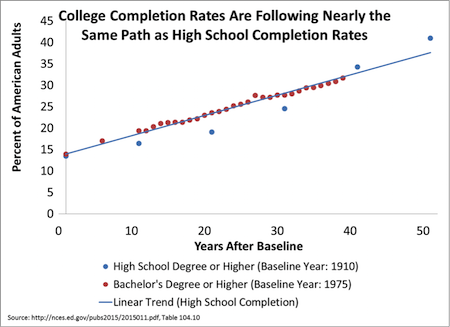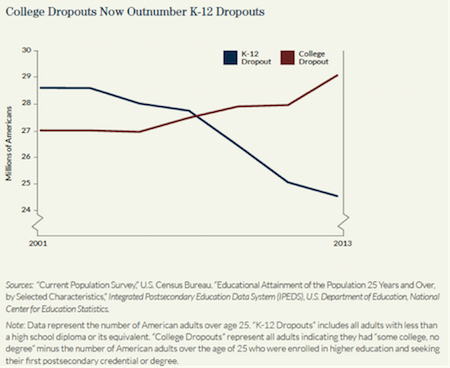With Congress busy debating the future of federal education policy, here’s a thought-provoking statistic: American adults in the 1940s had about the same odds of being a high school graduate as today’s Americans have of being a college graduate.
Beyond the pure shock value of this dramatic shift, it begs the question of whether the two rates will grow at the same rates. Will we boost college attainment rates in this century as fast as we increased high school attainment in the last century?
So far, they’re relatively close mirrors of each other. In 1910, 13.5 percent of American adults had a high school diploma. Forty years later, that figure had risen 21 percentage points. In 1975, 13.9 percent of American adults had a bachelor’s degree. 38 years later, that figure had risen 18 percentage points.
The graph below shows how these two trend lines look remarkably similar. The key question is what will happen next.

We already know what happened to high school attainment rates. We shifted from relatively slow progress through the first half of the 1900s into a much faster rate of growth between 1950 and 1980. In those 30 years, the percentage of American adults with a high school diploma or GED (General Education Diploma) doubled from 34.3 percent to 68.6 percent. Today we’re inching toward 90 percent of our adult population with a high school diploma or GED.
There are still schools with low graduation rates, but even those are falling fast. Nationwide the number of dropout factories—high schools with a graduation rate under 60 percent—declined from more than 2,007 in 2002 to 1,146 in 2013. Similarly, the number of students enrolled in those dropout factories plummeted from 2.6 million to 1.1 million, even as the total student population nationwide increased.
As I show in a new report for Bellwether Education Partners, rapid progress at the high school level, combined with very slow progress in postsecondary education, has led to dramatic changes in our society. And in 2009, the U.S. passed an almost-inevitable milestone: There are now more American adults who have dropped out of college than have dropped out of high school.

In pure, raw numbers, college dropouts are now a bigger problem than high school dropouts. Today there are 29.1 million college dropouts versus 24.5 million Americans with less than a high school diploma. It’s safe to predict that this trend will only accelerate as older generations with lower educational attainment rates are gradually replaced by new generations with higher attainment rates.
A number of factors contributed to these changes. In the labor market, employers send a powerful signal that they value candidates with higher levels of education. Individuals are more likely to be employed, and to earn higher wages, for higher levels of education. Compulsory attendance laws played a role too, accelerating high school attendance and completion rates. The introduction of the GED began as a way to offer returning World War II veterans a path to a high school diploma without having to go back to high school. Over time, it took on an even bigger role for other groups of high school dropouts. There are now 6 million Americans with a high school equivalency degree like the GED. That alone accounts for about 3 percent of the increase.
More recently, No Child Left Behind forced schools and districts to start paying attention to high school graduation rates. Those accountability mechanisms helped kickstart another push to get all students through high school, a reform that has particularly paid off for low-income and minority students and for students with disabilities.
Will college attainment rates keep making slow but steady progress, as they have over the past 40 years, or will we start to see faster growth like we did for high school attainment rates? In my recent paper, I argue that enhancing high school policies could be one lever for policymakers. If states truly held high schools accountable for what happens to their students after graduation, they would build robust portraits of high school quality that measured things like advanced high school course-taking rates, student engagement, and student outcomes in college and careers. All of these steps would ease the transition from high school into college.
But we shouldn’t let higher education institutions off the hook for oversubscribing students to remedial courses or for failing to graduate large portions of their students. It’s an open question whether we’ll make the equivalent policy adjustments in higher education as we did in K-12: will someone create a “GED for college” or will we start holding colleges accountable for their graduation rates to boost education attainment? The answers to these questions matter both to the individuals graduating today and to our broader society going forward.
— Chad Aldeman
This post originally appeared on Education Reform Now.


